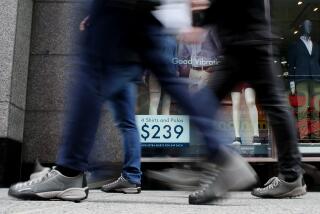Guarded Optimism Is Taking Shape in Asia
- Share via
SINGAPORE — Asia, which gave birth to the 15-month-old economic crisis that has circled the globe, has in the last few weeks shown encouraging signs that the worst may be over, according to Asian government, financial and corporate leaders.
They quickly add that recovery will take years and that the region remains vulnerable to unexpected new external shocks. Moreover, progress is uneven from country to country, and real economic growth is still a few quarters away.
Yet stabilizing Asian currencies and stock prices, declining interest rates and increased political resolve in Japan and elsewhere have contributed to growing optimism that the region has completed its headlong rush to the bottom.
“Asia’s outlook is improved,” said Duck-soo Han, Korea’s trade minister, agreeing with others that the worst appears to be over.
A bottoming-out in Asia would not halt the ripple effects of the region’s crisis that have spread to Russia and Latin America and begun to cause problems in the U.S. economy. The dynamics unleashed by the events in Asia, such as the drastic shrinkage of markets for U.S. goods, will play themselves out for many months.
But a halt to Asia’s decline would be an enormous tonic for world markets searching for signs that the frightening “Asian contagion” won’t go on forever.
“I think it’s going to be a long, hard road,” said Brian C. Lippy, managing director of Tokai Asia Ltd., a hedge fund backed by Japanese capital. “But there’s now some cautious optimism.”
One recent key change in the landscape, said representatives at a meeting of the World Economic Forum here this week, is an emerging Asian consensus on some tough steps needed to fix the underlying problems. The cornerstone is a recognition that public funds must be used to bail out bleeding banks, as politically unpalatable as that might be, and stimulate the economy.
Thailand, Malaysia, South Korea and, most recently, Japan have all climbed on board or are poised to use central bank funds or state budgets to prop up bank balance sheets.
The most dramatic such step has been Japan’s approval this week of bank reform legislation and a beefed-up bailout, after months of political paralysis, wrangling and false starts.
“It appears [Japan has] picked up the ball,” said John Ross, Asia-Pacific chief executive with Deutsche Bank Group. “Now let’s hope they continue to take it down court.”
The importance of an engaged Japan can hardly be overstated. Japan’s economy is twice the size of all other East Asian economies combined, China included. And its financial, manufacturing and trade influence extends across the region, with the Malaysian, Thai, Indonesian, Singaporean and Chinese economies heavily dependent on Japanese factories producing everything from cars and televisions to VCRs and household appliances.
“Japan is the Gordian knot of this whole thing,” said Tokai’s Lippy. “It has a huge multiplier effect on the region.”
A second cause for the recent guarded optimism has been improvements in several key market indicators. The worst of the region’s capital flight--the phenomenon that triggered all the trouble in July 1997--appears to be over, analysts say.
“The good news is . . . you can only panic once,” said Jeffrey Sachs, director of the Harvard Institute for International Development. “The short-term debt situation has stabilized in most countries.”
Regional currencies have by and large stabilized, a necessary precursor to reform and the eventual return of domestic economic growth. And the sky-high interest rates needed to anchor those currencies are coming down now that the worst of the currency threat seems to have passed.
Short-term Korean rates are now stable at 7% compared with about 25% in December, while interest rates in Thailand have dropped by 4 percentage points in the last few weeks to a prime rate of about 14.5%. Foreign currency reserves are also rising sharply in several countries--to $44 billion in South Korea from $3.8 billion late last year.
The statistics signal important real-life changes that suggest companies could face less pressure to lay people off, postpone investments and contract their operations.
A third major change has been a growing U.S. and European commitment to take the crisis seriously, view it in a global context and attempt some solutions.
Spurred by the almost simultaneous collapse of Wall Street and Russia in late summer, both regions have moved to keep their respective domestic growth rates on track--an essential step to avoid a global recession and ensure that Asia has some markets for its exports.
The U.S. Federal Reserve Board cut interest rates by a quarter of a percentage point earlier this month and the central banks of Spain, Britain and Canada, among others, followed suit. Germany’s new government is also seen as far more amenable to rate cuts than its predecessor. And the U.S. Congress this week finally appears ready to authorize additional International Monetary Fund funding.
These far-flung cuts in interest rates, meanwhile, have helped to bolster the Japanese yen. If sustained, that would further aid Asian companies and economies. The yen traded at 119.15 to the dollar Tuesday in New York, compared with a low of more than 147 seen Aug. 11.
“It’s good for us,” said Amaret Sila-on, chairman of Thailand’s Financial Sector Restructuring Authority, which is overseeing that nation’s bank bailout effort. “Japanese groups will not compete [so aggressively] with us, or with Southeast Asia. And it will be cheaper for the Japanese to import our products.”
Still, it’s far too early to be serving Singapore Slings. While many economies appear to have stopped their downward spiral, few can expect much growth before mid-1999, with Japan even later and credit likely to be tight for some time. Even the few nations expecting growth this year--China, Taiwan, Singapore and the Philippines--have sharply reduced their projections.
A great deal also rides on how the people on the streets of Bangkok, Jakarta and elsewhere who face job losses and dashed aspirations--a world away from the rarefied air of this week’s meeting of economists on Singapore’s prosperous waterfront--react to these tough times.
Indonesia, where street violence has already driven longtime leader Suharto from power, has not yet stabilized, analysts add, and will probably see its economy contract by a staggering 15% to 20% next year, driving millions more people into poverty.
Finally, Asia’s recovery is very much dependent on continued U.S. and European growth and Japanese stability. And Japan has given plenty of false starts before.
More to Read
Sign up for Essential California
The most important California stories and recommendations in your inbox every morning.
You may occasionally receive promotional content from the Los Angeles Times.













